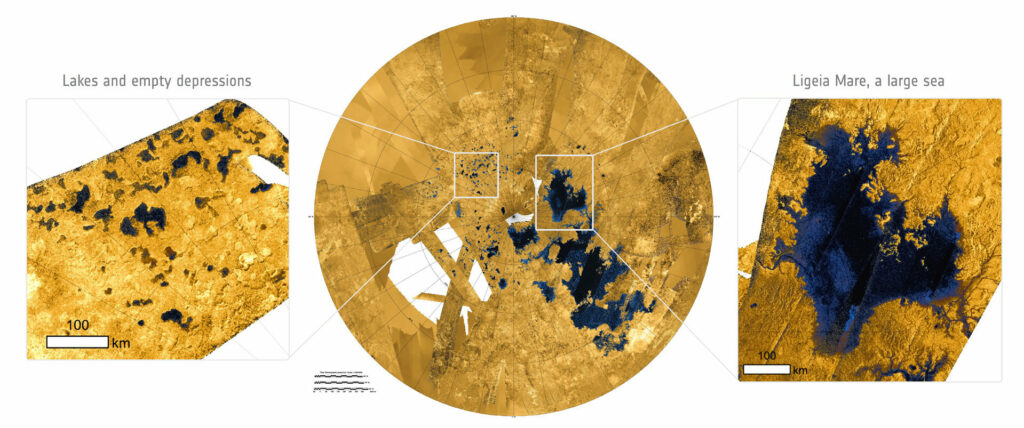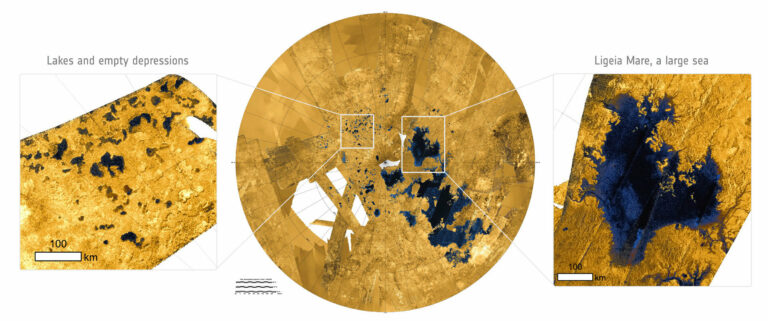Study Suggests Titan’s Enigmatic ‘Magic Islands’ are Likely Hydrocarbon Icebergs with a Honeycomb Structure
A recent study proposes that Titan’s enigmatic “magic islands” are probably floating portions of porous, frozen organic solids, a departure from previous research suggesting they were gas bubbles. Published in Geophysical Research Letters, the study delves into the hazy orange atmosphere of Titan, which is 50% thicker than Earth’s and rich in methane and other carbon-based molecules. Titan’s surface is characterized by dark dunes of organic material and liquid methane and ethane seas.
The radar imagery reveals shifting bright spots on the seas’ surfaces, known as “magic islands,” which have puzzled scientists since their discovery in 2014 during the Cassini-Huygens mission. Earlier studies speculated that these ephemeral islands could be either phantom islands caused by waves or real islands composed of suspended solids, floating solids, or nitrogen gas bubbles. Xinting Yu, the lead author of the new study and a planetary scientist, sought to explore the connection between Titan’s atmosphere, liquid lakes, and the solid materials on the moon’s surface to unravel the mystery of these islands. Yu expressed curiosity about whether the magic islands might be organics akin to floating pumice on Earth, which initially floats on water before eventually sinking.

A weird world of organics
Titan’s upper atmosphere harbors a dense array of diverse organic molecules that can aggregate, freeze, and descend onto the moon’s surface, including its remarkably smooth rivers and lakes of liquid methane and ethane, featuring waves merely a few millimeters tall. Xinting Yu and her research team delved into the destiny of these organic clusters upon reaching Titan’s hydrocarbon lakes, pondering whether they would sink or remain afloat. Their initial inquiry focused on whether Titan’s organic solids would dissolve in the methane lakes, but the team concluded that the saturated nature of the lakes with organic particles would prevent such dissolution.
“To observe the magic islands, they can’t just momentarily float and then sink,” explained Yu. “They need to float for a considerable duration, not indefinitely.” Given that Titan’s lakes consist primarily of low-surface-tension methane and ethane, posing challenges for solids to float, the team employed models to discern that most frozen solids were too dense and possessed insufficient surface tension to generate the elusive magic islands—unless the clumps exhibited a porous structure akin to Swiss cheese.
The modeling indicated that individual clumps were likely too diminutive to float independently. However, if these clumps congregated near the shore, forming larger, porous structures, pieces could detach and float away, resembling the process of glaciers calving on Earth. The amalgamation of increased size and appropriate porosity could account for the phenomenon of Titan’s magic islands. Moreover, the study proposed that a delicate layer of frozen solids enveloping Titan’s seas and lakes could elucidate the unusual smoothness of these liquid bodies. Consequently, the research outcomes offer potential explanations for two of Titan’s intriguing mysteries.
This article is republished from PhysORG under a Creative Commons license. Read the original article.
Do not forget to share your opinion with us to provide you with the best posts !




0 Comments